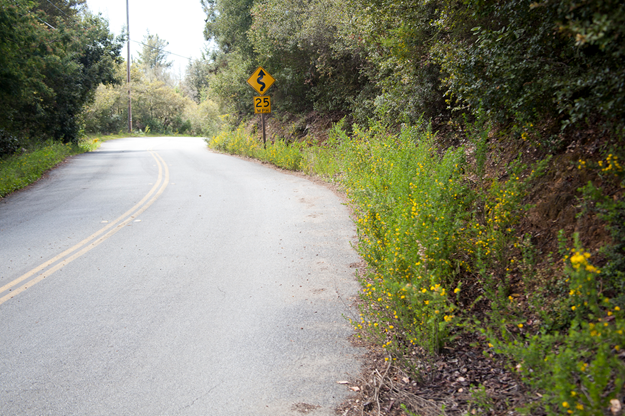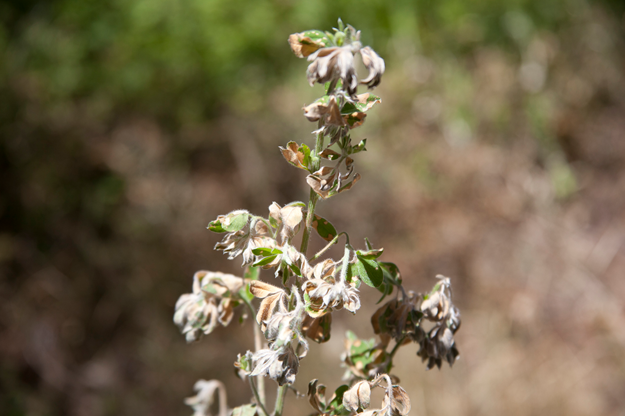Spring 2012: Herbicides for vegetation control on roadsides
Regional Report for Santa Cruz and Monterey Counties by Steve Tjosvold
The County of Santa Cruz maintains approximately 340 miles of road that are actively managed for weed control. Traditionally, vegetation management has consisted of an initial mowing, where necessary to reduce biomass, followed by a carefully timed glyphosate application as it regrows. This often eliminated the need for additional vegetation control measures for the remainder of the year. Glyphosate, however, has received considerable attention by groups and individuals questioning its safety in the environment, and the Santa Cruz County Board of Supervisors established a moratorium on roadside spraying on county-maintained roadways. Mowing was left as the only viable option for roadside vegetation management, but mowing was more than 275% the cost of a comparable glyphosate application (in a 2010 analysis). Moreover, management is especially difficult because French broom (Genista monspessulana) is one of the most common and important invasive weeds found growing on these roadways, as well as other areas of the central coastal area and other parts of California (fig. 1.) It resprouts readily from the root crown and is a prodigious seed producer. In light of budgetary constraints that the County faces, the purpose of our research was to evaluate the use of alternatives to glyphosate, especially those herbicides that are organic, biorational, or exhibit characteristics that could be used for vegetation management in a sustainable way.

Fig. 1. French broom (Genista monspessulana) was a common invasive weed found in this herbicide efficacy study on Santa Cruz County roadways.
The trial was established along Empire Grade Road near Bonny Doon, California. The site was heavily infested with French broom. There was a single application of herbicide on May 4, 2010 in replicated and randomized plots, followed by evaluations of weed control at intervals after the application (2 weeks and 1, 2, and 4 months). As expected, glyphosate was found to be very effective in controlling French broom and many other weeds. Products that had some systemic activity — aminopyralid + triclopyr (Milestone) and glufosinate (Finale) — were effective in killing some smaller French broom plants (basal diameters less than 9 millimeters) and inhibiting growth of larger plants. The organic and other contact herbicides — lemongrass oil (Greenmatch EX), 20% acetic acid (Weed Pharm), clove oil (Matran), and pelargonic acid (Scythe) — did not kill French broom. French broom and other perennial weeds recovered quickly, in almost all cases, just 2 weeks after herbicide treatment (fig. 2). The applications were repeated on May 5, 2011 to the same experimental plots, and showed similar but more profound results. For example, desirable native California bunch grasses started to establish in the plots treated with aminopyralid + triclopyr, a broad leaf herbicide, while the plots treated with glyphosate were almost devoid of vegetation. The French broom plants in the organic lemongrass oil plots were very similar to those in plots that were left untreated.

Figure 2. Typical symptoms 2 weeks following a contact herbicide application. In this case clove oil (Matran) was applied. Note that the foliar burn was incomplete, and some vegetative buds sprouted from stems.
Of the contact herbicide group we tested, pelargonic acid and clove oil desiccated foliage most effectively and therefore showed the greatest promise for management with repeated applications. We therefore established another trial using pelargonic acid with multiple applications, each application timed after there was some regrowth of French broom (Sept. 7, Oct.27 and Dec.7, 2011). The trial is still ongoing, but so far we have demonstrated that at least 3 successive applications might be needed for killing French broom.
Steven A. Tjosvold
Farm Advisor, Environmental Horticulture
UC Cooperative Extension Santa Cruz County
1432 Freedom Boulevard, Watsonville, CA 95076-2796
(831) 763-8013 phone, (831) 763-8006 fax
satjosvold@ucdavis.edu
http://cesantacruz.ucdavis.edu












